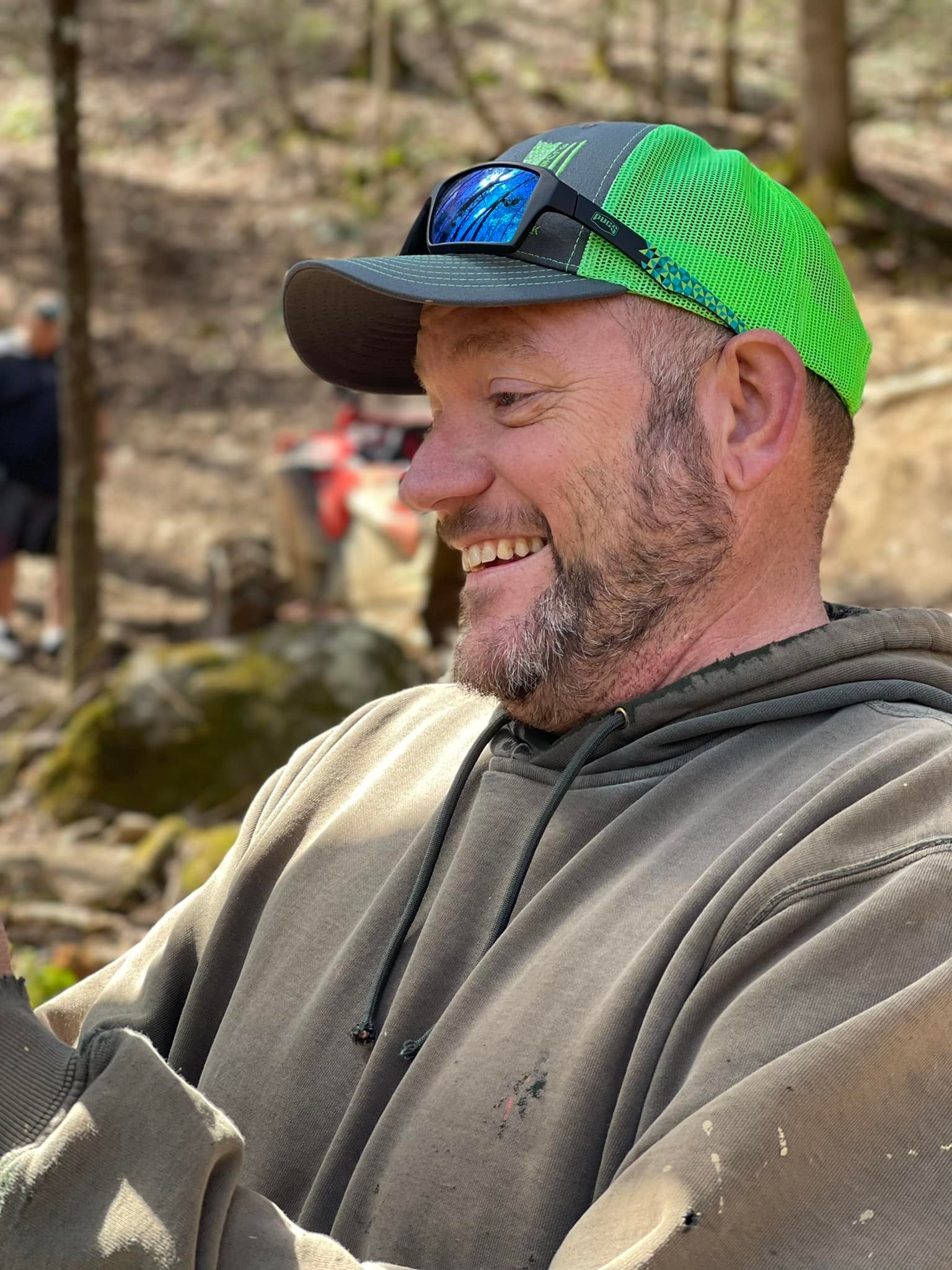Whether you are roasting a turkey for the first time on a Weber grill or just need to make your holiday meal special. Regardless of the Weber grill you choose, be it gas or charcoal, this guide will make cooking your turkey with tons of flavor. This method allows you to roast any type of turkey—big, medium, or small; brined or not; free-range or otherwise—on Weber grills in the easiest and simplest way.
Grilling a turkey on a Weber requires a bit of patience, the right technique, and an understanding of temperature control to achieve that perfect balance of crispy skin, tender meat, and well-seasoned flavor. It’s so delicious, you’ll be eager to enjoy it again before the Thanksgiving holidays.
Cooking Turkey on a Weber Gas Grill:
Follow these steps to make grilling turkey easier on your Weber gas grill.
Turkey Preparation
Preparing the turkey is essential before grilling. This method applies to both gas and charcoal grills from Weber. You can also ignore this method and jump to the next heading which is ready the gas grill and ready weber charcoal grill.
Pick out a great turkey!
To pick out a great turkey, you need to consider your guests. My personal suggestion is to choose one pound per person, and if you are serving big eaters, then increase the limit to one and a half pounds per person.
Now, picking out a turkey depends on your preference: fresh or frozen. Fresh turkey is more convenient as it doesn’t require thawing, but it can be expensive and needs to be bought closer to the cooking day. Frozen turkeys are readily available and often cost less than fresh ones. You can purchase them in advance, but remember to allow ample time for thawing in the refrigerator or a cooler (approximately 24 hours for every 4 to 5 pounds of turkey).
Make sure the turkey fits!
Before purchasing your turkey, it’s important to consider the dimensions and cooking capacity of your Weber grill. Some models may not perfectly fit a turkey. Check the manufacturer’s specifications to understand the maximum size of poultry or roast that can comfortably fit.
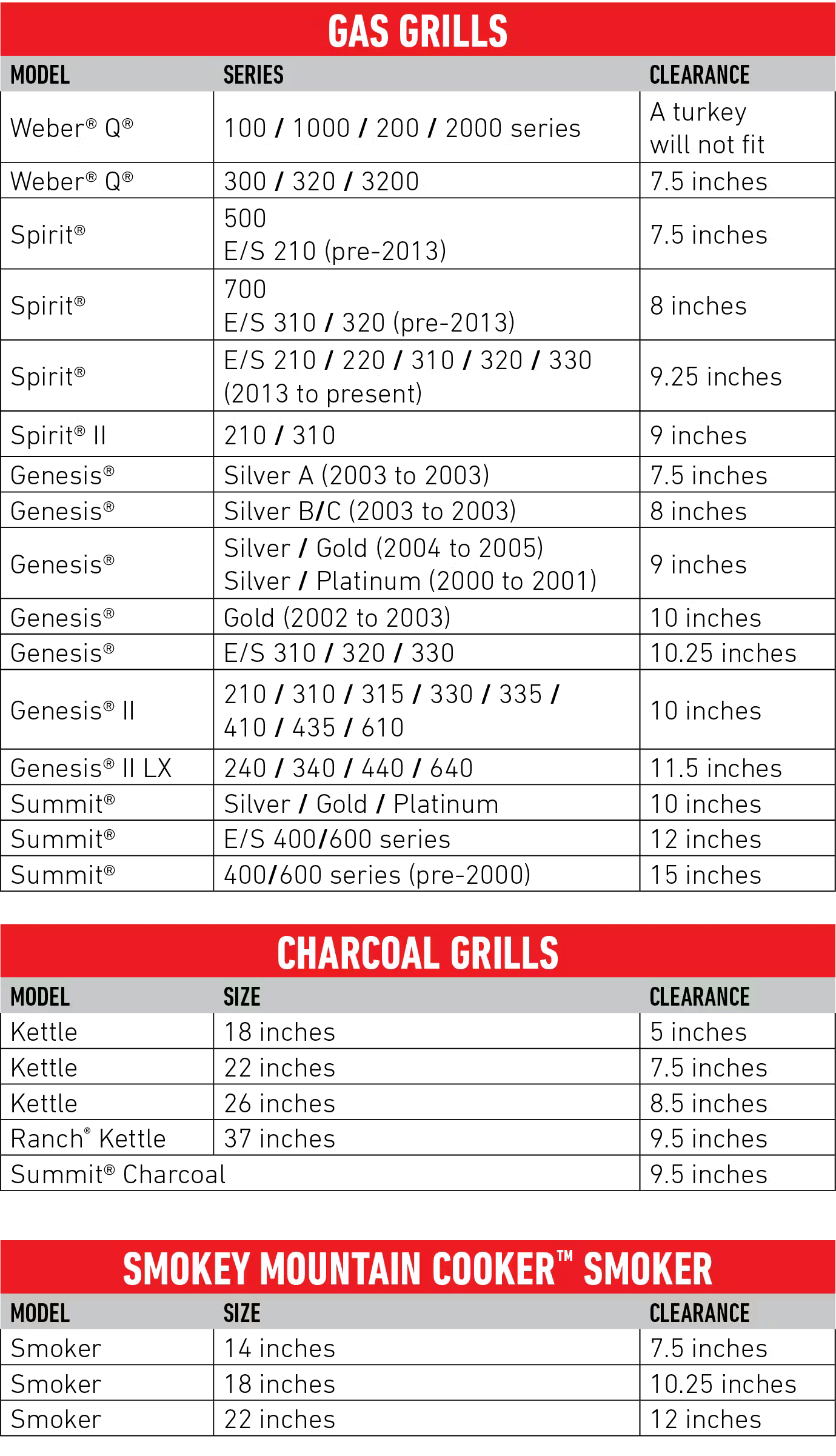
Brining
Brining can add up to 20% extra weight to your turkey. For example, if you have a 20-pound turkey and brine it, it may increase to 24 pounds. However, during cooking, it may lose around 20% of its weight, returning to its original weight for the meal. Whether you choose wet or dry brining, it will penetrate the turkey for a flavor boost.
Add flavor!
If you want to make your turkey deliciously flavorful, follow these methods to help you add various flavors to the turkey.
- Using wood helps infuse savory aromas into the turkey, enhancing its some smoke flavor. Consider fruit woods like pear, pecan, hickory, oak, or walnut for a delicious twist on your turkey.
- Season it under the skin with flavorful liquids like broth, or butter during cooking for added moisture and taste.
- Stuff the cavity of the bird with aromatic herbs, fruits (such as apples and oranges), and vegetables ( such as onions, celery and peppers).
- Now season the outside with olive oil, pepper, salt, garlic, and any other seasonings you enjoy.
- Using a marinade injector filled with butter or apple juice adds tons of flavor and moisture directly into the turkey meat.
Experimenting with these techniques helps to cook a turkey bursting with delicious flavors.

Cheesecloth On Your Turkey
When starting to cook turkey on the grill, using a soaked cheesecloth is a great way to prevent the turkey breast from becoming too dry or dark. You can just use it for the first half of the cooking time (About 30 minutes before the turkey is done cooking). If you’re cooking with wood, the skin may darken, but using cheesecloth will help protect it and give the skin a good golden brown color.
To use cheesecloth, cut a piece large enough to cover your turkey. Soak the cheesecloth in a mixture of melted butter and herbs, sauce, or broth. This not only prevents the cheesecloth from burning but also infuses the turkey with additional flavor as it cooks. Ensure that the cheesecloth is thoroughly saturated.
Truss
Trussing a turkey before grilling it on your Weber grill is a useful technique to ensure even cooking. Now, you need to secure the wings, legs, and drumsticks because they tend to stick out everywhere.
- You need a piece of twine that’s about four times the length of the whole turkey. Use it to wrap and secure the bird properly.
- The right position to make it easier to apply the twine around the bird is to place the bird on its backbone with the drumsticks facing you and the breast away, preparing it for trussing.
- Use the middle piece of twine to reach around the turkey and loop it over the nub of the neck.
- Wrap both strands of twine around the breast, above the wings, and attach them at the cavity behind the bird.
- Tie the twine at the cavity, starting the knot with a double loop. Pull the knot tight to plump up the breast.
- Bring the twine ends up around the ends of the drumsticks, then pull them tight so the drumsticks come together and are pulled up towards the tail. Cross the twine over the drumsticks, wrap it around, and tie it securely, making sure it’s tight enough to hold the legs together but not so tight that it cuts into the meat.
- Now finish off the knot and cut the extra left twine. Source
Grill Preparation
When using a gas grill, prioritize safety by checking the gas line and connections for leaks. Before cooking, preheat the grill by turning on the burner to high for about 15 minutes to burn off any residue. This prevents sticking and ensures your turkey doesn’t pick up flavors from previous cookouts. Also, confirm that the gas tank is not running out of gas mid-cook.
If you are using a gas grill, you will need to use wood chips. Personally, when I use a gas grill, I mix different flavors, such as one and a half handfuls of pear wood and one handful of red oak. Before using them in the grill, soak them for almost 40 minutes to 2 hours. Now, put them into the smoker box. It depends on the type of grill you are using; in the latest models, there is a maximum chance that your Weber grill comes with a pre-built smoker box.
Place a foil pan with approximately 2 to 3 liters of water on the flavorizer bars under your turkey or roast. If you want to make gravy, use just 1 liter of water to catch those flavorful juices, which can turn into the most delicious gravy you’ve ever tasted.
Cooking Time
For cooking a turkey, set up the grill to use an indirect heat method. With this method, you do not cook the turkey directly over the lit flame of the burner. For this, you need to preheat your grill for 15-20 minutes before placing the turkey inside. Follow these temperature guidelines.
225-250 °F 23-27 minutes per lb.
275-300 °F 18-21 minutes per lb.
350-375 °F 11-13 minutes per lb.
Adjust by 3 minutes for each pound if it is cold. Check the temperature when you consider it halfway through cooking, when you estimate it’s 75% done, and then when you think it’s completely done (making sure it’s not overcooked) using a reliable meat thermometer. For added convenience, you can even use a Weber Connect Smart Grilling Hub, which sends notifications to your mobile device and as well it is Compatible with any grill.

Make sure the turkey is fully cooked to an internal temperature of 165°F (74°C) in the thickest part of the breast and thigh. Try to avoid opening the lid too often, as this will prolong the cooking time.
How to Tell When It’s Done
The turkey could cook quicker than you think, use Weber smart gadgets can help you to get alerts at your phone
It is important to note that you should allow the turkey to rest for 20-30% of the total cooking time. During this period, cover the turkey with either loose aluminum foil or leave it uncovered.
Cooking Turkey on a Weber charcoal Grill:
Grilling a turkey on a kettle grill, such as a Weber Kettle, is a rewarding way to achieve a deliciously smoky flavor that oven roasting can’t match. Smoking on a kettle grill is a pretty easy process. It depends on the temperature range you select for the turkey. For charcoal, you can follow the same temperature range that I provided.
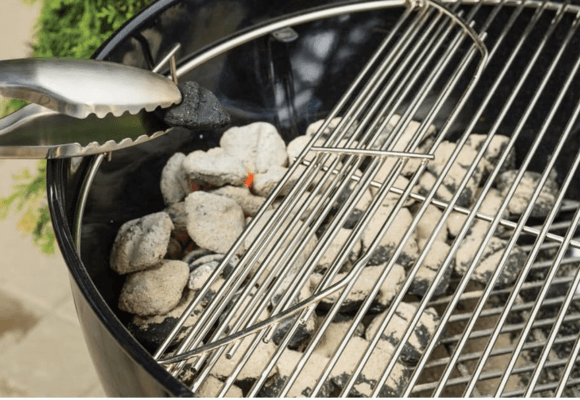
Prepare the Turkey
You can also follow your own recipe for turkey roasting, but before grilling, you need to prepare the turkey first. Here is the quickest outline for turkey.
- Pick out the best turkey,
- Brine it,
- Add flavor,
- Truss the turkey,
- Use cheesecloth.
Prepare Your Grill
Before preparing it for grilling, clean the grill thoroughly. Ensure that the grill grates are clean and the ash catcher is emptied to promote better airflow. There are various ways people use to prepare their charcoal grill. Here, I’ll provide you with two methods that work for both slow and quick cooking.
For low and slow at 225-250 degrees:
Fill the chimney starter to one-third of its total capacity with briquettes, approximately 20-30 briquettes, and ignite them. Stay calm until you see a little of their surface covered with ash before using them for grilling as well it also works great with BBQs.
Now, dump the chimney with lit charcoal onto one side of the charcoal grate of the grill and place a large drip pan next to it. This catches drips, prevents flare-ups, and adds humidity, helping to keep the turkey moist. Additionally, it helps maintain consistent and stable heat.
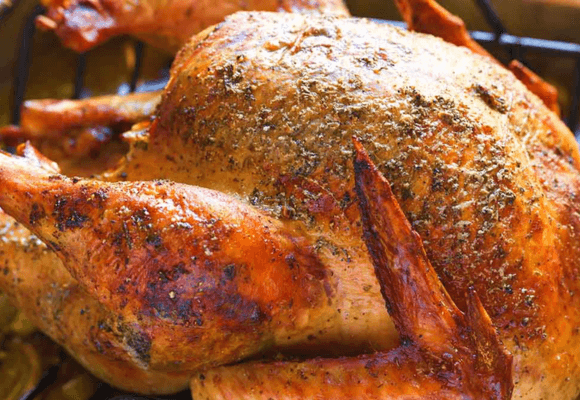
Adjust the vents to maintain a low cooking temperature between 225°F and 250°F. You can control the temperature by opening the vents to increase heat and closing them slightly to reduce heat. Use a Weber Connect grill thermometer to monitor the temperature closely. With this, you can spend more time with family and receive alerts on your mobile device.
For roasting at 275- 300 or 350-375 degrees:
In this method, you need to fill the chimney starter with charcoal (40-60 briquettes), light them, and wait until show ashed over.
Dump the lit charcoal on both sides of the kettle and place a large drip pan in the center. This is used to catch drippings and act as a heat sink.
Now, place the cooking grate so that the hinged part of the grate is over the charcoal. This helps increase the presence of more charcoal easily.
Adjust the grill vents to maintain the internal grill temperature. So you need to lock the bottom vent about a quarter of the way and initially set the top vent to be slightly open. Opening the vents will let in more air, raising the temperature, while closing them slightly will reduce the airflow and lower the temperature.
Always start with a preheated grill for 10-15 minutes. Five minutes into the preheat, use some wood chunks to lit the charcoal in a line on the top. For optimal flavor you can use a ratio 3:1 of peach and hickory.
Now, cover the grill and adjust the lid. Avoid frequently opening the lid to check on the turkey. Instead, use a wireless or leave-in meat thermometer like the Weber Connect. This allows you to monitor the turkey’s internal temperature without lifting the lid and receive notifications on your mobile device. The mobile application is compatible with iPhones and most smartphones on Android.
When grilling, try to add 5-10 unlit briquettes every single hour to maintain the temperature of the Weber charcoal grill.
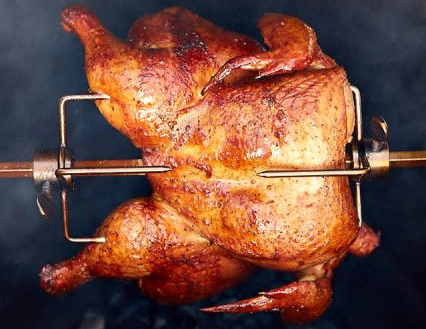
Tips Roasting Turkey On A Weber Gas & Charcoal Grill
Use of rotisserie
If you prepare turkey in a BBQ style, you can utilize the Weber rotisserie. This kit is compatible with charcoal, gas, and electric grills. The rotation of the rotisserie ensures even cooking of the turkey (or any other meat) on all sides. When using it, the spit rod and forks will become very hot. Handle them with heat-resistant gloves.
Easiest Turkey Recipe (Perfect for Thanksgiving Day)—Dry-brine the turkey for up to two nights, keeping it as simple as possible with kosher salt and pepper. Use a wireless Weber thermometer to monitor the temperature. It’s an effortless recipe; you simply set it and forget it.
